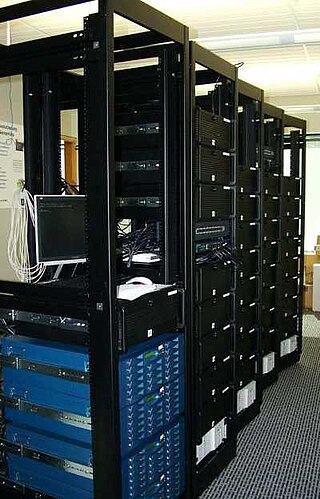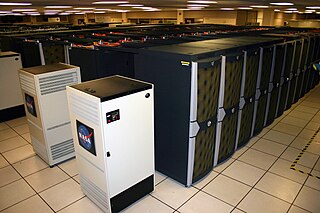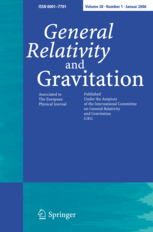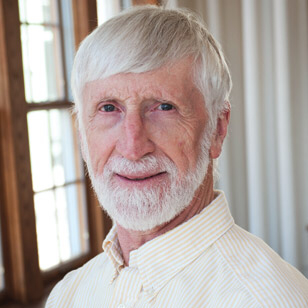
In physics, gravity (from Latin gravitas 'weight') is a fundamental interaction which causes mutual attraction between all things that have mass. Gravity is, by far, the weakest of the four fundamental interactions, approximately 1038 times weaker than the strong interaction, 1036 times weaker than the electromagnetic force and 1029 times weaker than the weak interaction. As a result, it has no significant influence at the level of subatomic particles. However, gravity is the most significant interaction between objects at the macroscopic scale, and it determines the motion of planets, stars, galaxies, and even light.

The Max Planck Institute for Gravitational Physics is a Max Planck Institute whose research is aimed at investigating Einstein's theory of relativity and beyond: Mathematics, quantum gravity, astrophysical relativity, and gravitational-wave astronomy. The institute was founded in 1995 and is located in the Potsdam Science Park in Golm, Potsdam and in Hannover where it closely collaborates with the Leibniz University Hannover. Both the Potsdam and the Hannover parts of the institute are organized in three research departments and host a number of independent research groups.
The Texas Advanced Computing Center (TACC) at the University of Texas at Austin, United States, is an advanced computing research center that is based on comprehensive advanced computing resources and supports services to researchers in Texas and across the U.S. The mission of TACC is to enable discoveries that advance science and society through the application of advanced computing technologies. Specializing in high performance computing, scientific visualization, data analysis & storage systems, software, research & development and portal interfaces, TACC deploys and operates advanced computational infrastructure to enable the research activities of faculty, staff, and students of UT Austin. TACC also provides consulting, technical documentation, and training to support researchers who use these resources. TACC staff members conduct research and development in applications and algorithms, computing systems design/architecture, and programming tools and environments.
Gravity Pipe is a project which uses hardware acceleration to perform gravitational computations. Integrated with Beowulf-style commodity computers, the GRAPE system calculates the force of gravity that a given mass, such as a star, exerts on others. The project resides at Tokyo University.

Jürgen Ehlers was a German physicist who contributed to the understanding of Albert Einstein's theory of general relativity. From graduate and postgraduate work in Pascual Jordan's relativity research group at Hamburg University, he held various posts as a lecturer and, later, as a professor before joining the Max Planck Institute for Astrophysics in Munich as a director. In 1995, he became the founding director of the newly created Max Planck Institute for Gravitational Physics in Potsdam, Germany.

gravitySimulator is a novel supercomputer that incorporates special-purpose GRAPE hardware to solve the gravitational n-body problem. It is housed in the Center for Computational Relativity and Gravitation (CCRG) at the Rochester Institute of Technology. It became operational in 2005.

Pleiades is a petascale supercomputer housed at the NASA Advanced Supercomputing (NAS) facility at NASA's Ames Research Center located at Moffett Field near Mountain View, California. It is maintained by NASA and partners Hewlett Packard Enterprise and Intel.
David Roy Merritt is an American astrophysicist.
The National Center for Computational Sciences (NCCS) is a United States Department of Energy (DOE) Leadership Computing Facility that houses the Oak Ridge Leadership Computing Facility (OLCF), a DOE Office of Science User Facility charged with helping researchers solve challenging scientific problems of global interest with a combination of leading high-performance computing (HPC) resources and international expertise in scientific computing.
The National Institute for Computational Sciences (NICS) is funded by the National Science Foundation and managed by the University of Tennessee. NICS was home to Kraken, the most powerful computer in the world managed by academia. The NICS petascale scientific computing environment is housed at Oak Ridge National Laboratory (ORNL), home to the world's most powerful computing complex. The mission of NICS, a member of the Extreme Science and Engineering Discovery Environment (XSEDE - formerly TeraGrid), is to enable the scientific discoveries of researchers nationwide by providing leading-edge computational resources, together with support for their effective use, and leveraging extensive partnership opportunities.
The Center for Gravitational Wave Astronomy (CGWA) is a research center at the University of Texas Rio Grande Valley (UTRGV). Its core mission is "to further scientific research and education in gravitational wave astronomy". It was founded in 2003 at the UTRGV's predecessor institution UT Brownsville, through a grant from NASA's University Research Centers program.
The International Journal of Modern Physics is a series of Physics journals published by World Scientific.

General Relativity and Gravitation is a monthly peer-reviewed scientific journal. It was established in 1970, and is published by Springer Science+Business Media under the auspices of the International Society on General Relativity and Gravitation. The two editors-in-chief are Pablo Laguna and Mairi Sakellariadou; former editors include George Francis Rayner Ellis, Hermann Nicolai, Abhay Ashtekar, and Roy Maartens. The journal's field of interest is modern gravitational physics, encompassing all theoretical and experimental aspects of general relativity and gravitation.

Japan operates a number of centers for supercomputing which hold world records in speed, with the K computer becoming the world's fastest in June 2011. and Fugaku took the lead in June 2020, and furthered it, as of November 2020, to 3 times faster than number two computer.

Computational astrophysics refers to the methods and computing tools developed and used in astrophysics research. Like computational chemistry or computational physics, it is both a specific branch of theoretical astrophysics and an interdisciplinary field relying on computer science, mathematics, and wider physics. Computational astrophysics is most often studied through an applied mathematics or astrophysics programme at PhD level.
The University of California High-Performance AstroComputing Center (UC-HiPACC), based at the University of California at Santa Cruz (UCSC), is a consortium of nine University of California campuses and three Department of Energy laboratories. The consortium's goal is to support and facilitate original research and education in computational astrophysics, and to engage in public outreach and education.

Carlos O. Lousto is a Distinguished Professor in the School of Mathematical Sciences in Rochester Institute of Technology, known for his work on black hole collisions.
Manuela Campanelli is a distinguished professor of astrophysics and mathematical sciences of the Rochester Institute of Technology, and the director of its Center for Computational Relativity and Gravitation and Astrophysics and Space Sciences Institute for Research Excellence. Her work focuses on the astrophysics of merging black holes and neutron stars, which are powerful sources of gravitational waves, electromagnetic radiation and relativistic jets. This research is central to the new field of multi-messenger astronomy.

Andrew J. Hanson is an American theoretical physicist and computer scientist. Hanson is best known in theoretical physics as the co-discoverer of the Eguchi-Hanson Metric, the first Gravitational instanton. This Einstein metric is asymptotically locally Euclidean and self-dual, closely parallel to the Yang-Mills instanton. He is also known as the co-author of Constrained Hamiltonian Systems and of Gravitation, Gauge Theories, and Differential Geometry, which attempted to bridge the gap between theoretical physicists and mathematicians at a time when concepts relevant to the two disciplines were rapidly unifying. His subsequent work in computer science focused on computer graphics and visualization of exotic mathematical objects, including widely used images of the Calabi-Yau quintic cross-sections used to represent the hidden dimensions of 10-dimensional string theory. He is the author of Visualizing Quaternions.
Gabrielle D. Allen is a British and American computational astrophysicist known for her work in astrophysical simulations and multi-messenger astronomy, and as one of the original developers of the Cactus Framework for parallel scientific computation. She is a professor of mathematics and statistics at the University of Wyoming.










